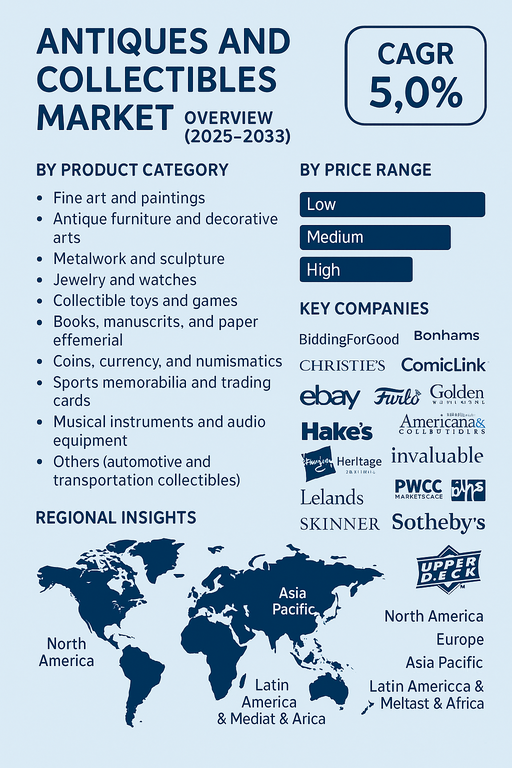The global antiques and collectibles market is projected to grow at a CAGR of 5.0% from 2025 to 2033, fueled by increasing interest in cultural heritage, rising disposable incomes among collectors, and expanding digital auction platforms. Antiques and collectibles represent a wide spectrum of products, ranging from fine art and jewelry to sports memorabilia and trading cards. Growing demand for rare and unique items, coupled with the rise of online marketplaces, is broadening participation among both seasoned collectors and younger demographics.

Growing Popularity of Online and Cross-Border Trade
The antiques and collectibles industry is witnessing significant transformation with the growth of online platforms and digital auctions. Traditional auction houses and new-age marketplaces are increasingly leveraging technology to reach global audiences. Collectors are now able to participate in real-time bidding and access rare items from different geographies. Authentication services, blockchain-based provenance verification, and the gamification of collectibles (e.g., limited-edition trading cards and toys) are enhancing buyer confidence and engagement. Younger consumers are driving demand for pop culture collectibles, sports memorabilia, and gaming-related items, creating new growth opportunities alongside traditional art and antiques.
Challenges: Authenticity Concerns and Market Volatility
The market faces challenges related to counterfeit items, uncertain valuation, and authenticity risks, which can undermine buyer trust. High-value antiques and collectibles often require extensive verification, and fraudulent listings on digital platforms pose reputational risks. Market volatility is another concern, as collectibles are heavily influenced by changing consumer tastes and speculative trends. Additionally, the high cost of rare antiques and limited accessibility for new buyers restrict broader adoption. However, advancements in authentication technologies, digital certification, and increased transparency from auction houses are helping to address these challenges.
Market Segmentation by Product Category
By product category, the market includes fine art and paintings, antique furniture and decorative arts, metalwork and sculpture, jewelry and watches, collectible toys and games, books/manuscripts/paper ephemeral, coins/currency/numismatics, sports memorabilia and trading cards, musical instruments and audio equipment, and others (automotive and transportation collectibles). Fine art, paintings, and jewelry remain dominant segments, attracting high-value collectors. Sports memorabilia, trading cards, and pop culture collectibles are the fastest-growing categories, supported by younger collectors and celebrity endorsements.
Market Segmentation by Price Range
By price range, the market is segmented into low, medium, and high. The low and medium segments represent broad participation, with online platforms driving accessible pricing for entry-level collectors. The high-price range remains concentrated among rare fine art, jewelry, and historically significant items, with auctions driving multi-million-dollar valuations.
Regional Insights
In 2024, North America led the antiques and collectibles market, driven by strong participation in auctions, high disposable incomes, and cultural interest in collectibles. Europe followed closely, with the UK, France, and Germany acting as hubs for fine art and antique trade. Asia Pacific is the fastest-growing region, with rising wealth in China, India, and Japan fueling demand for luxury collectibles and heritage items. Latin America and Middle East & Africa (MEA) are emerging markets, where growing cultural tourism and online accessibility are creating opportunities for local and international collectibles.
Competitive Landscape
The 2024 market was shaped by both traditional auction houses and modern digital platforms. Sotheby’s, Christie’s International, Bonhams, and Skinner remain leaders in fine art, antiques, and luxury auctions. Heritage Auctions, Golden Auctions, and PWCC Marketplace specialize in sports memorabilia, trading cards, and comics. Stanley Gibbons Group is a key player in philately and numismatics, while RR Auction and Hake’s Americana & Collectibles focus on historical memorabilia. eBay, Invaluable, ComicLink, and BiddingForGood provide online marketplaces for broad categories of collectibles. Consumer-focused brands such as Funko, Hasbro, and The Upper Deck Company dominate the pop culture and gaming collectibles space. Competitive differentiation is increasingly being shaped by digital engagement, authenticity verification, global reach, and the ability to appeal to new generations of collectors.
Historical & Forecast Period
This study report represents analysis of each segment from 2023 to 2033 considering 2024 as the base year. Compounded Annual Growth Rate (CAGR) for each of the respective segments estimated for the forecast period of 2025 to 2033.
The current report comprises of quantitative market estimations for each micro market for every geographical region and qualitative market analysis such as micro and macro environment analysis, market trends, competitive intelligence, segment analysis, porters five force model, top winning strategies, top investment markets, emerging trends and technological analysis, case studies, strategic conclusions and recommendations and other key market insights.
Research Methodology
The complete research study was conducted in three phases, namely: secondary research, primary research, and expert panel review. key data point that enables the estimation of Antiques and Collectibles market are as follows:
Market forecast was performed through proprietary software that analyzes various qualitative and quantitative factors. Growth rate and CAGR were estimated through intensive secondary and primary research. Data triangulation across various data points provides accuracy across various analyzed market segments in the report. Application of both top down and bottom-up approach for validation of market estimation assures logical, methodical and mathematical consistency of the quantitative data.
| ATTRIBUTE | DETAILS |
|---|---|
| Research Period | 2023-2033 |
| Base Year | 2024 |
| Forecast Period | 2025-2033 |
| Historical Year | 2023 |
| Unit | USD Million |
| Segmentation | |
Product Category
| |
Price Range
| |
End Use
| |
Distribution Channel
| |
|
Region Segment (2023-2033; US$ Million)
|
Key questions answered in this report